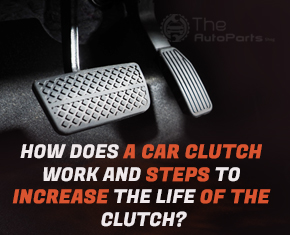You might be surprised to learn that a manual gearbox automobile has more than one clutch. It turns out that people who drive automatic transmission automobiles have clutches as well. In reality, clutches may be found in many items you see or use every day. Many cordless drills have a clutch, chain saws have a centrifugal clutch, and certain yo-yos have them as well.
In this article, you’ll learn why you need a clutch, how your car’s clutch works, and where you may find clutches in fascinating, and sometimes surprising locations.
Clutches are helpful in equipment having two spinning shafts, such as automobiles. One of the shafts is usually powered by a motor or pulley, while the other shaft is used to power another equipment. The clutch joins the two shafts, allowing them to be locked together and spin at the same speed or decoupled and spin at separate rates.
A clutch is required in an automobile since this engine spins continuously but the wheels do not. To stop an automobile without stopping the engine, the wheels must be detached from the engine in some way. By managing the slippage between them, the clutch allows us to seamlessly engage a spinning engine to a non-spinning gearbox.
To understand how a clutch works, it’s helpful to understand friction, which is a measure of how difficult it is to move one thing over another. Friction is created by the peaks and valleys that are inherent in all surfaces – even the smoothest surfaces include minuscule peaks and valleys. The greater the peaks and valleys, the more difficult it is to move the object.
Tips for Increasing the Life of Your Car’s Clutch
The clutch is the link between the engine and the transmission of a vehicle. The clutch is responsible for transferring engine power to the gear. The main components of a clutch system are the flywheel, clutch plate, and pressure plate. Improper usage might cause the clutch to fail prematurely and shorten its life.
Understanding how to utilise the clutch helps extend the clutch system’s life. You can save money by not having to repair the clutch as frequently. Following the suggestions we mention here will significantly extend the life of your car’s clutch.
1. Avoid Resting Your Foot on the Clutch
It’s customary to keep your foot on the clutch pedal even when it’s not in use. Resting the foot on the pedal while keeping the clutch depressed engages the pressure plate, forcing the friction plate to come into contact, producing wear and tear. As a result, the system’s service life will be reduced.
Keep in mind that the clutch pedal is not your footrest. It is a component of the vehicle’s transmission system. Careless use of the system might have serious consequences for the vehicle’s performance.
2. Frequent usage of the clutch pedal can result in significant wear and tear.
Many people hit the brake & clutch pedals at the same time. This habit might be the result of poor guidance during the first driving learning phase. Only use the clutch when the engine power is low and you need to change gears. Otherwise, you are engaging the clutch needlessly, which increases usage and wear and tear.
With practise, you will recognise when the engine power is decreasing or increasing and when the gear has to be changed. Only press the clutch pedal once. Depress the clutch, change the gear, then carefully disengage it. That is the move you need to do.
3. Using Half-clutch at Steep Climb Stops
People consider it brave to keep the clutch slightly engaged while waiting for a difficult ascent. Instead of using the handbrake, they employ the half-clutch technique to keep the car from rolling backward. You are unnecessarily loading the clutch. In such cases, using the handbrake is preferable. This problem may not exist in vehicles with automatic transmissions. However, if you drive a manual car, you must use a handbrake.
4. After racing the RPM, launch the vehicle.
This is more common in newbies who just started driving. They would use the brake, keep the clutch down, increase the engine RPM, and then rapidly activate the clutch. This would eventually cause the clutch mechanism to wear out quickly. Many people emulate it from action movies, believing that it is noble. Nonetheless, it is a hazardous pastime that can result in fatalities.
5. Holding the Clutch Engaged at Stoplights
While waiting at a traffic light, it is advisable to put the car in neutral and apply the handbrake. Instead of doing this, many people leave the clutch half-engaged. Maintaining the car in half-clutch mode undoubtedly requires more work and energy. When you arrive at a traffic light, put the car in neutral and apply the hand brakes. It would not only keep the clutch in good working order, but it would also conserve gasoline.
6. The Clutch is Affected by Engine Braking
Engine braking may be required in certain circumstances. However, it has an effect on the clutch system’s health. Those who believe engine braking is necessary should study and practise the proper engine braking approach. It is preferable to reduce engine braking and rely more on conventional braking. You can use engine braking in perilous situations where standard braking might cause the car to slide.
How Do You Keep Your Car Clutch Healthy?
We can’t completely abandon the clutch. In such a situation, it would not have been present in an automobile. Practicing good clutch system usage can save you a considerable amount of money on clutch system replacement.
1.Make it a habit to only use the clutch when absolutely required.
2.Educate yourself on how to use it properly.
3.Keep your foot away from the clutch when it is not necessary to utilise it (especially on highways).
4.Periodic servicing should include proper clutch system maintenance.
A properly-maintained automobile may both operate well and keep its owner safe. When you own a vehicle, you must acquire the habit of good maintenance.
